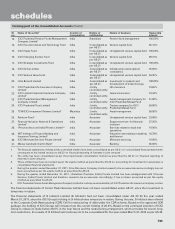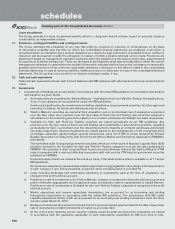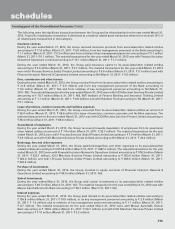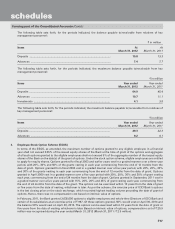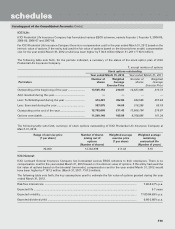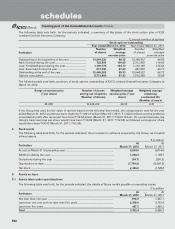ICICI Bank 2012 Annual Report Download - page 148
Download and view the complete annual report
Please find page 148 of the 2012 ICICI Bank annual report below. You can navigate through the pages in the report by either clicking on the pages listed below, or by using the keyword search tool below to find specific information within the annual report.
F70
Leave encashment
The Group provides for leave encashment benefit, which is a long-term benefit scheme, based on actuarial valuation
conducted by an independent actuary.
11. Provisions, contingent liabilities and contingent assets
The Group estimates the probability of any loss that might be incurred on outcome of contingencies on the basis
of information available upto the date on which the consolidated financial statements are prepared. A provision is
recognised when an enterprise has a present obligation as a result of a past event and it is probable that an outflow of
resources will be required to settle the obligation, in respect of which a reliable estimate can be made. Provisions are
determined based on management estimate required to settle the obligation at the balance sheet date, supplemented
by experience of similar transactions. These are reviewed at each balance sheet date and adjusted to reflect the current
management estimates. In cases where the available information indicates that the loss on the contingency is reasonably
possible but the amount of loss cannot be reasonably estimated, a disclosure to this effect is made in the consolidated
financial statements. In case of remote possibility, neither provision nor disclosure is made in the consolidated financial
statements. The Group does not account for or disclose contingent assets, if any.
12. Cash and cash equivalents
Cash and cash equivalents include cash in hand, balances with RBI, balances with other banks and money at call and short
notice.
13. Investments
i) Investments of the Bank are accounted for in accordance with the extant RBI guidelines on investment classification
and valuation as given below.
a) All investments are classified into ‘Held to Maturity’, ‘Available for Sale’ and ‘Held for Trading’. Reclassifications,
if any, in any category are accounted for as per the RBI guidelines.
Under each classification, the investments are further classified as (a) government securities, (b) other approved
securities, (c) shares, (d) bonds and debentures and (e) others.
b) ‘Held to Maturity’ securities are carried at their acquisition cost or at amortised cost, if acquired at a premium
over the face value. Any premium over the face value of fixed rate and floating rate securities acquired is
amortised over the remaining period to maturity on a constant yield basis and straight line basis respectively.
c) ‘Available for Sale’ and ‘Held for Trading’ securities are valued periodically as per RBI guidelines. Any
premium over the face value of fixed rate and floating rate investments in government securities, classified
as ‘Available for Sale’, is amortised over the remaining period to maturity on constant yield basis and straight
line basis respectively. Quoted investments are valued based on the trades/quotes on the recognised stock
exchanges, subsidiary general ledger account transactions, price list of RBI or prices declared by Primary
Dealers Association of India jointly with Fixed Income Money Market and Derivatives Association (FIMMDA),
periodically.
The market/fair value of unquoted government securities which are in the nature of Statutory Liquidity Ratio (SLR)
securities included in the ‘Available for Sale’ and ‘Held for Trading’ categories is as per the rates published by
FIMMDA. The valuation of other unquoted fixed income securities wherever linked to the Yield-to-Maturity (YTM)
rates, is computed with a mark-up (reflecting associated credit risk) over the YTM rates for government securities
published by FIMMDA.
Unquoted equity shares are valued at the break-up value, if the latest balance sheet is available or at ` 1 as per
RBI guidelines.
Securities are valued scrip-wise and depreciation/appreciation is aggregated for each category. Net appreciation
in each category, if any, being unrealised, is ignored, while net depreciation is provided for.
d) Costs including brokerage and commission pertaining to investments, paid at the time of acquisition, are
charged to the profit and loss account.
e)
Profit/loss on sale of investments in the ‘Held to Maturity’ category is recognised in the profit and loss account and
profit is thereafter appropriated (net of applicable taxes and statutory reserve requirements) to Capital Reserve.
Profit/loss on sale of investments in ‘Available for sale’ and ‘Held for Trading’ categories is recognised in the profit
and loss account.
f) Market repurchase and reverse repurchase transactions, are accounted for as borrowing and lending
transactions respectively in accordance with the extant RBI guidelines. The transactions with RBI under
Liquidity Adjustment Facility (LAF) are accounted for as borrowing and lending transactions from the three
months ended March 31, 2012.
g) Broken period interest (the amount of interest from the previous interest payment date till the date of purchase/
sale of instruments) on debt instruments is treated as a revenue item.
h) At the end of each reporting period, security receipts issued by asset reconstruction companies are valued
in accordance with the guidelines applicable to such instruments, prescribed by RBI from time to time.
forming part of the Consolidated Accounts (Contd.)
schedules







